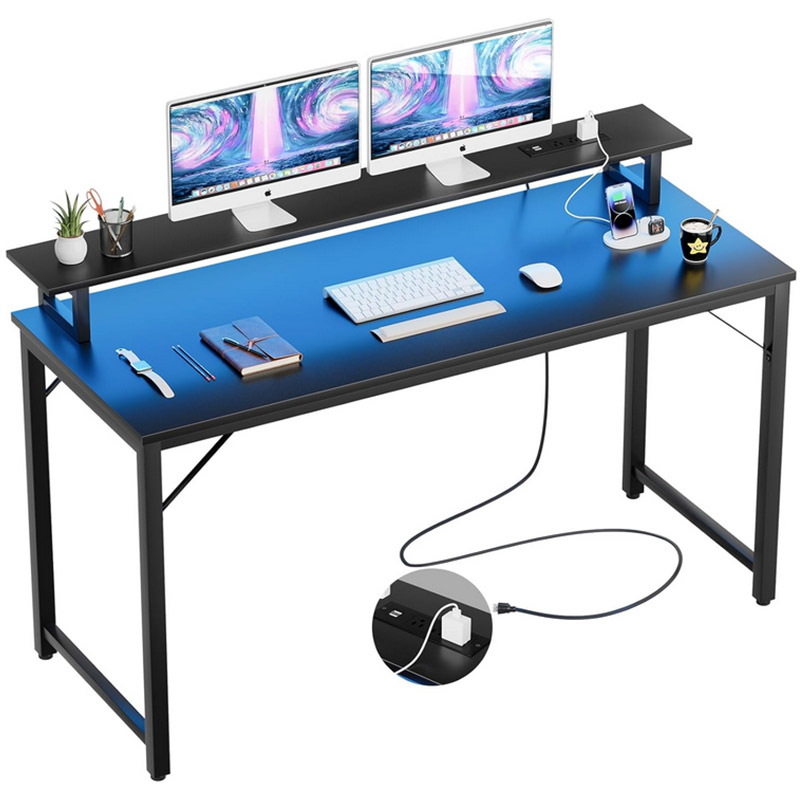How Much Weight Can A Computer Desk Hold
Selecting a Computer Desk involves more than just aesthetics and size. For a workspace that is both safe and durable, understanding its weight capacity is paramount. A desk that sags, wobbles, or fails under load compromises your equipment's safety and your productivity.
As a manufacturer of framed furniture, we engineer our desks for strength and longevity. This guide will explain the key factors that determine a desk's load capacity and how to choose one that reliably supports your setup.
1. Key Factors Determining Weight Capacity
The load-bearing capability of a computer desk is not a single number but a result of its entire construction.
Frame Material and Construction: This is the most critical factor. Desks built with solid wood or steel frames offer the highest structural integrity and weight capacity. High-quality engineered wood (like plywood or MDF) paired with a robust internal frame can also provide excellent support. The design of the frame—particularly the presence of center supports, gussets, and the thickness of the legs—is what prevents wobble and sagging over time.
Desktop Surface Material: The material of the desk top itself must resist bending.
Solid Wood: Very strong, but can be heavy and expensive.
High-Pressure Laminate (HPL) over Particleboard: A common and cost-effective option. The weight limit depends heavily on the thickness of the particleboard core and the strength of the underlying frame.
Plywood or MDF: Generally stronger and more resistant to sagging than particleboard, especially in longer spans.
Thickness of the Desktop: A thicker desktop (e.g., 1 inch / 25mm) will naturally resist bending and hold more weight than a thinner (e.g., ⁵⁄₈ inch / 16mm) one, even if they are the same material.
Design and Span: The distance between the desk's supports (legs or frame) is a major factor. A long, open span with no center support will have a lower effective weight capacity than a desk with a leg or support beam in the middle. Desks with a structural apron (a horizontal frame member set back from the edge) provide significant additional support to the desktop.
2. General Weight Capacity Classifications
While you must always check the manufacturer's specified limit, desks generally fall into these categories:
Standard Duty (50 - 100 lbs / 23 - 45 kg): SuiTable for a laptop, monitor, and basic desk accessories. Many entry-level, mass-market desks fall into this range.
Medium Duty (100 - 200 lbs / 45 - 90 kg): Can comfortably support two monitors, a desktop computer tower placed on the desk, and other peripherals. This is a common range for well-built, framed desks designed for home offices and professionals.
Heavy Duty / Professional (200+ lbs / 90+ kg): Engineered to hold multiple large monitors, heavy equipment, and professional gear like drafting boards or large-scale printers. These desks feature solid wood or reinforced steel frames and often have a minimal span between supports.
3. How to Calculate Your Setup's Weight
To ensure your desk is adequate, make a rough estimate of your equipment:
Monitors: 10 - 30 lbs (4.5 - 13.5 kg) each
Desktop Computer Tower: 20 - 50 lbs (9 - 23 kg)
Desktop PC (all-in-one): 15 - 30 lbs (7 - 13.5 kg)
Laptop: 3 - 8 lbs (1.5 - 3.5 kg)
Monitor Arm: 5 - 20 lbs (2 - 9 kg)
Books, Printer, and Other Items: Easily 20 - 50 lbs (9 - 23 kg)
Total Example: Two monitors (40 lbs) + a PC tower (30 lbs) + a monitor arm (10 lbs) + books and peripherals (30 lbs) = 110 lbs (50 kg). A medium-duty desk would be the minimum recommendation for this setup.

4. The Importance of Manufacturer Specifications
Always look for the manufacturer's stated maximum weight capacity. This figure is the result of engineering calculations and stress tests. Reputable manufacturers will provide this information clearly in product specifications.
Do not assume a desk can hold more than its stated capacity. Exceeding it can lead to structural failure, damage to your property, and potential injury.
5. Maximizing Stability and Longevity
Even Distribution: Distribute weight evenly across the desk surface instead of concentrating it all in one spot.
Avoid Sagging: For longer desks (over 55 inches), a center support leg or a solid back frame is highly recommended to prevent the desktop from sagging in the middle over time.
Check and Tighten: Periodically check and tighten any bolts or screws in the frame to maintain stability.
Conclusion
Choosing a suitable computer stand is very important for your office work. We hope that after reading this article, you can choose the product you like. If you have any questions about this, please feel free to contact us.
Previous: Are Gaming Desks Worth It

